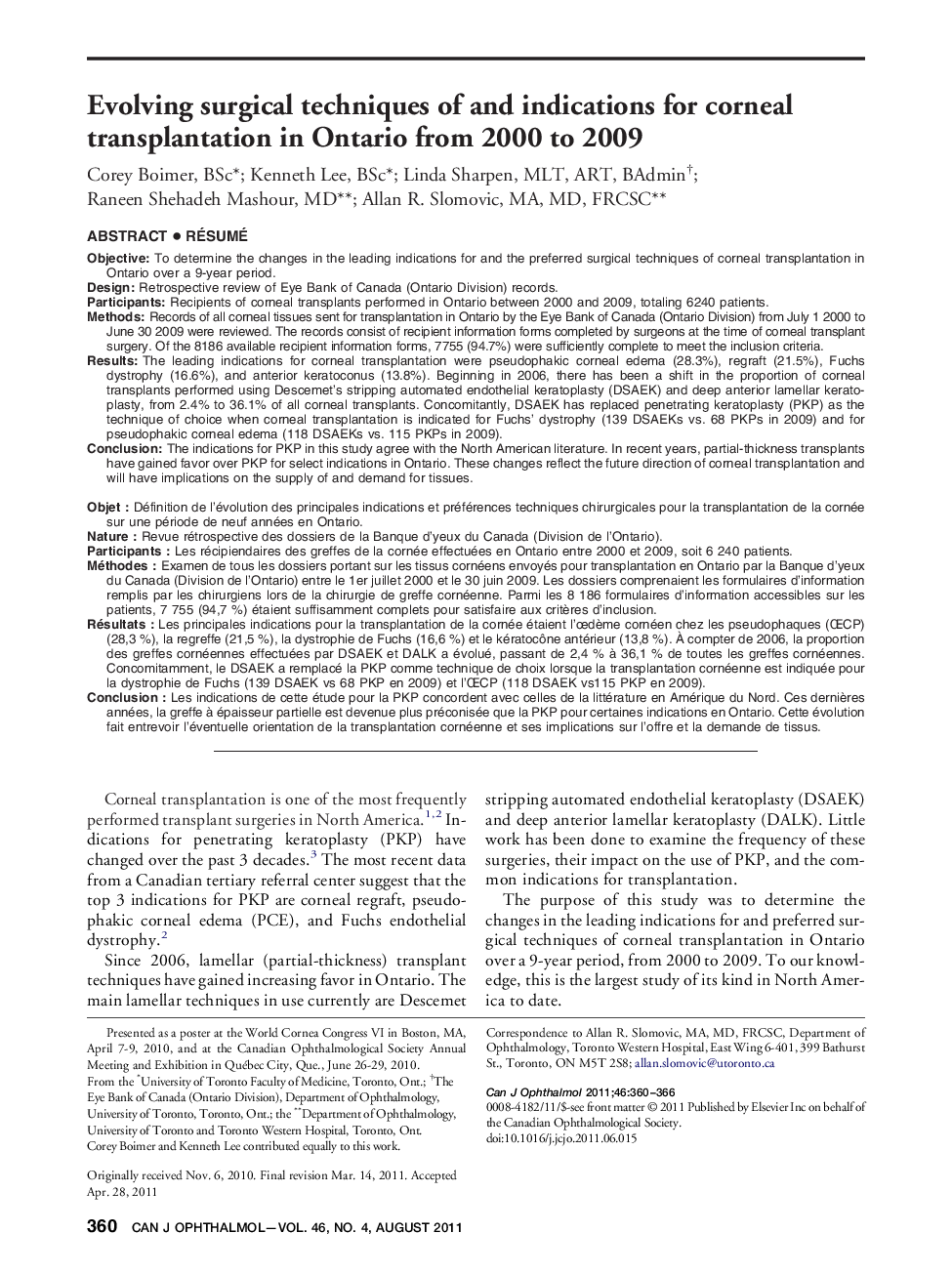| کد مقاله | کد نشریه | سال انتشار | مقاله انگلیسی | نسخه تمام متن |
|---|---|---|---|---|
| 4009620 | 1602422 | 2011 | 7 صفحه PDF | دانلود رایگان |

ObjectiveTo determine the changes in the leading indications for and the preferred surgical techniques of corneal transplantation in Ontario over a 9-year period.DesignRetrospective review of Eye Bank of Canada (Ontario Division) records.ParticipantsRecipients of corneal transplants performed in Ontario between 2000 and 2009, totaling 6240 patients.MethodsRecords of all corneal tissues sent for transplantation in Ontario by the Eye Bank of Canada (Ontario Division) from July 1 2000 to June 30 2009 were reviewed. The records consist of recipient information forms completed by surgeons at the time of corneal transplant surgery. Of the 8186 available recipient information forms, 7755 (94.7%) were sufficiently complete to meet the inclusion criteria.ResultsThe leading indications for corneal transplantation were pseudophakic corneal edema (28.3%), regraft (21.5%), Fuchs dystrophy (16.6%), and anterior keratoconus (13.8%). Beginning in 2006, there has been a shift in the proportion of corneal transplants performed using Descemet's stripping automated endothelial keratoplasty (DSAEK) and deep anterior lamellar keratoplasty, from 2.4% to 36.1% of all corneal transplants. Concomitantly, DSAEK has replaced penetrating keratoplasty (PKP) as the technique of choice when corneal transplantation is indicated for Fuchs' dystrophy (139 DSAEKs vs. 68 PKPs in 2009) and for pseudophakic corneal edema (118 DSAEKs vs. 115 PKPs in 2009).ConclusionThe indications for PKP in this study agree with the North American literature. In recent years, partial-thickness transplants have gained favor over PKP for select indications in Ontario. These changes reflect the future direction of corneal transplantation and will have implications on the supply of and demand for tissues.
RésuméObjetDéfinition de l’évolution des principales indications et préférences techniques chirurgicales pour la transplantation de la cornée sur une période de neuf années en Ontario.NatureRevue rétrospective des dossiers de la Banque d’yeux du Canada (Division de l’Ontario).ParticipantsLes récipiendaires des greffes de la cornée effectuées en Ontario entre 2000 et 2009, soit 6 240 patients.MéthodesExamen de tous les dossiers portant sur les tissus cornéens envoyés pour transplantation en Ontario par la Banque d’yeux du Canada (Division de l’Ontario) entre le 1er juillet 2000 et le 30 juin 2009. Les dossiers comprenaient les formulaires d’information remplis par les chirurgiens lors de la chirurgie de greffe cornéenne. Parmi les 8 186 formulaires d’information accessibles sur les patients, 7 755 (94,7 %) étaient suffisamment complets pour satisfaire aux critères d’inclusion.RésultatsLes principales indications pour la transplantation de la cornée étaient l’œdème cornéen chez les pseudophaques (ŒCP) (28,3 %), la regreffe (21,5 %), la dystrophie de Fuchs (16,6 %) et le kératocône antérieur (13,8 %). À compter de 2006, la proportion des greffes cornéennes effectuées par DSAEK et DALK a évolué, passant de 2,4 % à 36,1 % de toutes les greffes cornéennes. Concomitamment, le DSAEK a remplacé la PKP comme technique de choix lorsque la transplantation cornéenne est indiquée pour la dystrophie de Fuchs (139 DSAEK vs 68 PKP en 2009) et l’ŒCP (118 DSAEK vs115 PKP en 2009).ConclusionLes indications de cette étude pour la PKP concordent avec celles de la littérature en Amérique du Nord. Ces dernières années, la greffe à épaisseur partielle est devenue plus préconisée que la PKP pour certaines indications en Ontario. Cette évolution fait entrevoir l’éventuelle orientation de la transplantation cornéenne et ses implications sur l’offre et la demande de tissus.
Journal: Canadian Journal of Ophthalmology / Journal Canadien d'Ophtalmologie - Volume 46, Issue 4, August 2011, Pages 360–366